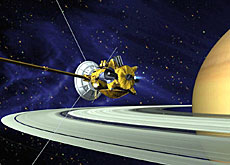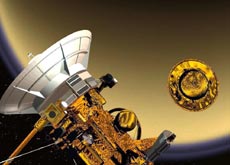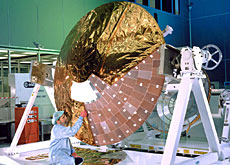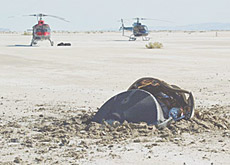Space probe sends images from Titan

The Huygens probe has sent back the first pictures of Saturn’s largest moon, Titan, after entering its atmosphere on Friday.
Some of the technology on board the ambitious Huygens-Cassini mission was supplied by Zurich-based Contraves Space.
The first scientific data arrived at the European Space Operations Centre in the German city of Darmstadt at 17:19 Central European Time on Friday.
Pictures taken during the probe’s more than two-hour descent by parachute to the surface showed a mix of icy land and liquid.
The first three photos of Titan revealed boulders of ice, drainage channels, shorelines and islands.
Scientists said they had received more than three hours of data, including hundreds of pictures, from Huygens’ descent, and more than ten minutes of data from the surface.
The orbiter for the space journey, Cassini, was built by Nasa in the United States, while the European Space Agency was mainly responsible for the Huygens probe.
The arrival of Huygens on Titan had been much awaited after it broke away from the mother ship on December 25.
Huygens is mankind’s first successful attempt to land a probe on another world in the outer solar system.
Contraves CEO Umberto Somaini spoke to swissinfo as Huygens was due to land on the surface.
He said the firm was relieved and very happy that the mission had been successful, and that the Swiss-built mechanisms to release and protect the probe had withstood the heat pressure.
swissinfo: It appears the mission has been successful, can you describe your feelings at this point?
Umberto Somaini: When analysis of the data from the separation on Christmas Day showed that the probe had been put on its trajectory to Titan absolutely precisely that gave us a good feeling. But this morning Huygens started to enter Titan’s atmosphere at high speed and that was a very crucial part of the mission.
We were all, of course, relieved and happy to hear that the probe had survived.
swissinfo: You have described this as a delicate mission. Is its likely success down to luck or good planning?
U.S.: This mission started in the late 1980s, and of course it was planned very painstakingly. Those involved in the programme took the time to do all the testing necessary and consider what could happen.
But there is always the unknown. We have never been to Titan, the atmosphere was not known to us. There is always the risk of mission failure, but we did everything to keep that within limits.
What we see here is a combination of a little bit of luck, good planning and good execution of all parts of this programme.
swissinfo: We saw from the Beagle Mission to Mars that it’s very easy for things to go badly wrong. It must have always been at the back of your mind that something would go wrong this time?
U.S.: Yes, you base all your designs and testing on information you have available. And although something was known of Titan’s atmosphere, we didn’t really know what the probe would meet when it entered.
But this mission was probably prepared in more detail [than Beagle] and you cannot really compare them. Beagle was really an opportunity mission, put together very rapidly and taking certain risks and short cuts. And, of course, you’re taking more risks when you go down that path than if you go a bit slower and address every potential risk.
swissinfo: What is the next space project for Contraves after this?
U.S.: There are a number of challenging projects planned. The one that we’re right in the midst of now is the telescope for the [2007] Planck mission, which is to detect the fine structure of the background radiation left over from the Big Bang.
This telescope has to be very precise and work at very low temperatures. So coming from the front shield design, which had to work at very high temperatures, we are now working on structures which have to work at minus 270 degrees – the opposite extreme.
swissinfo: What will the success of the Cassini-Huygens mission mean for Contraves?
U.S.: It’s from this kind of success that we get our motivation for the new challenges that lie ahead… It’s really a reward for all our hard work.
swissinfo-interview: Morven Mclean
Cassini-Huygens was launched from Florida in October 1997.
It took almost seven years to reach Saturn, travelling nearly 3.5 billion kilometres.
The 5.6-ton spacecraft is made up of two parts – the Cassini orbiter and the Huygens probe.
Three other Swiss companies and Bern University also contributed to the mission.
Cassini-Huygens is the first spacecraft to orbit Saturn.
Since arrival at Saturn on July 1, Cassini has been sending back new information about Saturn, its rings, moons and magnetic field.
Dutch astronomer Christiaan Huygens discovered Titan in 1655.
Italian-French astronomer Giovanni Cassini discovered Saturn actually had two main rings around it. The gap between them is still called the “Cassini Division”.

In compliance with the JTI standards
More: SWI swissinfo.ch certified by the Journalism Trust Initiative



You can find an overview of ongoing debates with our journalists here. Please join us!
If you want to start a conversation about a topic raised in this article or want to report factual errors, email us at english@swissinfo.ch.